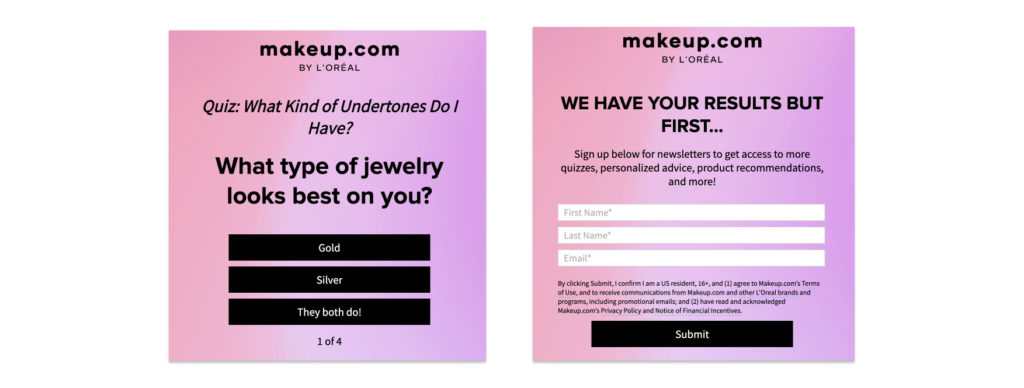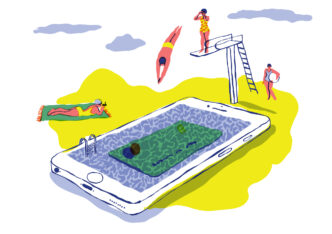

The takeaways:
- Brand publishers may well understand the benefits of this strategy, but many are unaware of the potential value that content can give them, especially when they learn lessons from traditional medias
- Engagement, data collection, personalization and sales activation are 4 key essentials for brand publishing success, as recommended by expert Quentin Paquot
- Above all, a combination of de-anonymization (registration) and interactive formats can prove hugely valuable for brands to turn their content into business
Given that publishing isn’t their main industry (in fact, it’s a completely new area for them), this isn’t hugely surprising. It’s a media-world where revenue streams for traditional publishers are well-established and clearly defined by the industry.
But how can brands learn from publishers to gain value from their content, effectively turning brand publishing into business?
To help answer this question, I spoke to Quentin Paquot, CEO of Qualifio, a specialist in interactive marketing, data collection and loyalty. Having worked with a wide variety of brand publishers in various industries, he shared 4 essentials for these companies to get business from the readers of their content.
The 4 essentials for brand publishing:
- Engagement
- Data collection
- Personalization
- Sales activation
1. Engagement
What specifically is engagement?
It’s one of those words we all understand but perhaps couldn’t clearly define and, in fact, you can find a variety of different definitions online.
At The Audiencers, engagement can be defined and tracked by combining the recency, frequency and volume of visits made by a user (known as a RFV score).
Recency = the number of days since a user was last active on your website
Frequency = the number of days that a user has accessed your site in a given time period
Volume = the quantity of content accessed and interacted with
Given that engagement directly correlates with revenue, it’s an essential metric to track and work hard to increase amongst readers.
One of the best ways for brand publishers to successful engage their readers is by forming habits, encouraging them to return to your content on a frequent and regular basis to consume a high quantity of articles. You can do this through a combination of on-site content formats, UX features and off-site techniques.
Newsletters: bringing content to your users on a regular basis to either fit into an existing habit (e.g. the morning commute) or create a new one.
Content series: just like a TV series, you leave your user wanting to come back for the next episode
Gamification: Quentin brought up the interactive content format of gamification, for instance publishing a new crossword each week, or simply integrating a game into your site to entertain and encourage better quality of visits (including more time spent on page)
The mineral water brand Vittel, for instance, ran an interactive online quiz for readers during Le Tour de France, increasing engagement and building a closer relationship with users.
UX features: parts of your site that allow users to personalize their experience and encourage high frequency of visits through bringing value directly in front of them. For instance, the ability to save content for later, follow topics or authors, easily share content on social media, etc.
The French Football Federation’s publishing site includes social sharing buttons, adds a tag to link to other related content and recommends further reading through article links at the side of the screen, based on the article we’re currently consuming.
Cross-channel experience – use a mix of channels to reach customers in various, complementary and cohesive ways, including push (email or push notifications on mobile) and pull notifications (in-app messages, content cards, etc that occur within your site or app).
2. Data collection
With Google’s cookie changes, GDPR compliance and other restrictions coming into play, the need for collecting owned data is becoming increasingly more vital for success.
Owned data?
Instead of relying on partners and third-party data suppliers, brand publishers need to collect first- and zero-party data that’s willingly shared by the consumer – i.e. they’re giving their permission for their data to be used with the expectation of something in return (such as a better brand experience, personalized messaging, promotions etc).
Combining de-anonymization (registration) with interactive content is the simplest way for brands to establish a successful owned data strategy and put this data to use in providing additional value to their audience.
Registration: Converting unknown users into registered members is a simple but highly effective way to collect data and create a single view of your users.
The most successful publishers and brands employ a registration wall to block content and ask or require users to create a free account to continue reading.
Whilst you collect key data points, your user gets access to more content and additional benefits defined by you, such as discounts, early-access to products or UX features (e.g. ability to save content for later or resume content where they left off).
For traditional publishers, registration has proven time and again to increase user-to-subscriber conversion rates by 10-15%. And, given that engagement plays a central role in a user’s decision to subscribe in this context, we can assume that registration can have an equally valuable impact on user-to-buyer conversion rates amongst brands.
Tbsp, by the brand General Mills, requires users to sign up when they try to make use of any member-only features, including the ability to save content for later.
Interactive content: quizzes or tests, either before or after registering your user, can help to collect key data points and increase engagement simultaneously
Quentin mentions Makeup.com by L’Oreal who built a quiz for readers to discover their undertones by answering 4 questions. In order to receive the results, the user had to create an account, with 60-70% of participants converting into a registered user through this format across all L’Oreal brands.

This also benefits sales at L’Oreal – users can be sent products that are adapted to their complexion, a data point that would be difficult to discover without this form of content.
3. Personalization
Personalized messaging has a significantly greater impact on potential customers than standard copy, and the large majority of online users now expect it, especially after creating an account.
Adding the user’s name, recommending content, personalizing messaging based on previous purchases… it’s all about putting your data to use to boost engagement, build close relationships and ultimately increase revenues.
Segment audiences: segment your audience based on level of engagement, location, interests, or anything that could prove valuable to your strategy. This is a simple way to personalize messaging, design and user journeys without having to over complicate matters
Triggers: set up triggers through a UTM_source that personalize the user experience based on their source. For instance, users coming from your newsletter could be given open access to premium content to help boost engagement.
Journal Du Dimanche, a French publisher, even set up a trigger for users coming from the news aggregator site upday, offering these readers access to premium content for free and encouraging registration to increase engagement. Given that upday is responsible for the acquisition of 8% of JDD’s traffic, it was important for the publisher to not turn these readers away with a paywall but instead nurture them, gradually making them aware of their premium offer.
Account space: for registered users, you can not only make the most of the data already collected (including email and preferred content/products) but also provide features that they can personalize themselves – such as a preference center for configuring notifications/emails, building a shopping list or ‘collections’ to save content in different areas.
BBC food allows users to save content in their ‘favorites’ as well as add ingredients to a shopping list.
4. Sales activation
Of course, engagement, data collection and personalization are great, but they’re only valuable to your business if converted into revenue. And, even better, these engaged users may well come back and purchase on a regular basis, recommending you to others and advocating your brand.
Web-to-store strategies: bring online users from your content to your store through promotions, rewards or even with the ‘shopping list builder’ used in the BBC Food example above.
Nespresso decided to employ a newsletter registration strategy for Black Friday, offering those who signed up the chance to receive exclusive offers and discounts. This strategy led users to both the online store and physical shop front.
Kiehl integrated a wheel of fortune into their site where users had to enter their email address to play and be in with a chance of winning a discount or prize.
Digital-to-physical strategies: bring the online to life
LOSC Lille football club went a step further in engaging their online users by bringing them to physical events. Specifically, they asked digital supporters to choose a song for the club’s warm-up session, with the winner having their name displayed on the giant screens. This created a sense of community, helping consumers to feel associated with the team as well as encouraging them to pay to watch the game in real life.
This article was written in collaboration with Qualifio, the Belgian MarTech SaaS company specializing in interactive marketing, data collection and loyalty. Quentin, who was interviewed for this content, is Qualifio’s CEO, having worked with them since 2014.












